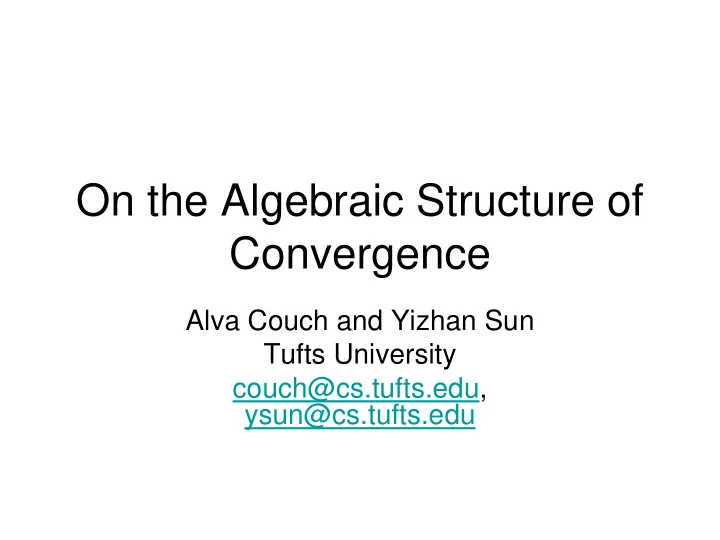

On the Algebraic Structure of Convergence Alva Couch and Yizhan Sun Tufts University couch@cs.tufts.edu, ysun@cs.tufts.edu
Background • System and network administration (network configuration management) • CFengine provides convergent behavior. • Observation: compositions of convergent processes are not always convergent. • Example: file editing.
Convergent Configuration Management Challenges • Why can compositions of convergent actions lead to confusing and even divergent behaviors? • What limits on practice will assure predictable responses to convergent processes?
Our Approach • Express self-healing as a result of applying sequences F (P) from a finite set of convergent operations P={ p 1 , p 2 , … p n }. • While F (P) is infinite, effects of F (P) on a particular machine are finite. • Express algebraic properties of F (P) as equivalence of effect , e.g., p ≈q means that p and q have the same effect. • Study factor structure F (P)/ ≈, a finite set of equivalence classes of operations.
Why Equivalences are Important • F (P)/ ≈ (the set of equivalent classes of operations) represents achievable states . • Expense of validating a self-healing system varies with the number of achievable states.
Kinds of Algebraic Equivalences • Idempotence: p i p i ≈ p i • Pairwise statelessness: p j p i p j ≈ p j p i • Statelessness: p n …p 1 p n ≈ p n …p 1 • Sequence idempotence (or idempotence of F (P)): p n …p 1 p n …p 1 ≈ p n …p 1 • Operations are written right to left, i.e., p n …p 1 (S)=p n (…(p 1 (S))…)
Preliminary Algebraic Results p i p i ≈p i p j p i p j ≈p j p i p n …p 1 p n ≈p n …p 1 p n …p 1 p n …p 1 ≈p n …p 1 p i ≈ {c ik :=d ik │k=1,2,… } (c ik ≠c jl for i ≠j)
Preliminary Algebraic Results p i p i ≈p i p j p i p j ≈p j p i straightforward subtle straightforward p n …p 1 p n ≈p n …p 1 straightforward p n …p 1 p n …p 1 ≈p n …p 1 very counter-intuitive! p i ≈ {c ik :=d ik │k=1,2,… } (c ik ≠c jl for i ≠j)
pp ≈p and qq≈q does not insure qpqp ≈qp • Baseline: x=y=0 • p: if (x==1) then y:=2 • q: x:=1 • qp: { x=1, y=0 } • qpqp = q(pq)p: { x=1, y=2 } • A composition qp of idempotent actions q,p need not be idempotent.
Case Study: CFengine File Editing editfiles: all:: { /etc/services hashCommentLinesContaining “tftp” appendIfNotPresent “tftp 6900/udp” } • Each operation by itself is convergent. • Paired, they fill the file with useless comments. • Consider what happens if one uses uncommentLinesContaining “tftp” on the result.
More Editing Problems • deleteLinesMatching “ftp” – Not specific enough; will delete lines containing “tftp” as well as “ftp”. • appendIfNotPresent “tftp 6800/udp” – Does not sense duplicate records with different port.
What Goes Wrong With Editing • Non-convergent compositions allow proliferation of latent states. • State proliferation causes uncertainty in applying further edits. • Problem is syntax. Instead we need something like: assert service=tftp port=6900 proto=udp retract service=tftp
Statelessness • A set of operations is stateless if the result of a single operation q is independent of any prior application: qp n …p 1 q ≈ qp n …p 1 • Property of a set of operations, not a single operation. • Depends upon choice of baseline state. • Sufficient but not necessary to prevent state proliferation.
Facts about Statelessness • Sufficient but not necessary to assure sequence idempotence: p n …p 1 p n …p 1 =p n …p 1 • Sequence idempotence has some nice properties: – Every sequence equivalent to one including each operation at most once – Resulting state space is finite with size ≤ 2 n , n=number of operations
A Curious Result • For stateless sets of operations, we can prove that configuration parameters exist! • A band is a semigroup for which all elements are idempotent: pp=p. • A commutative band is one in which pq=qp for all p,q. • A matrix band is one in which pq ≠qp for all p,q.
The Structure Theorem • If P is sequence-idempotent, then F (P)/ ≈ can be viewed as a commutative band of matrix bands of unit groups. Construction: – Express F(P)/ ≈ as a disjoint union of subsemigroups C i, where the C i form a semigroup themselves. – Define C j C i as the unique set C k where for c i in C i and c j in C j , c j c i is in C k . – This can be done to ensure that {C i } is commutative, while each C i by itself is a matrix band.
Inferred Parameters • C 1 …C m represent orthogonal parameters (C i C j =C j C i ) • Contents of each C i represent settings (c 1i c 2i ≠c i2 c i1 ) c i1 c i2 F(P)/ ≈ C 1 C 2 C m … … c il
Conclusions • Statelessness of operations leads to sequence idempotence • Sequence idempotence is highly desirable – Reduction of achievable states – Creation of an ideal parameter space • Achieving sequence idempotence requires changes in practice – Avoiding stream edits – Expressing changes as assertions.
Just a Beginning Configuration Best statelessness Path state machine practices analysis semigroup validation semigroup theory theory sequence Population Closures idempotence determinism Couch et al Subsystem LISA03 isolation observable distinction state refinement determinism verification Intrusion Local observable detection determinism Nonparametric idempotence statistics
More Information • Alva L. Couch Computer Science Tufts University Medford, MA USA 02155 couch@cs.tufts.edu • LISA Paper: Couch, Hart, Greenlee, and Kallas, “Seeking Closure in an Open World”, Proc. LISA03, Oct 29-31,2003
Recommend
More recommend